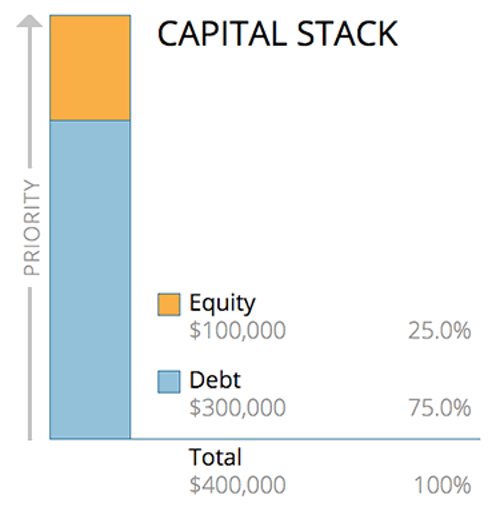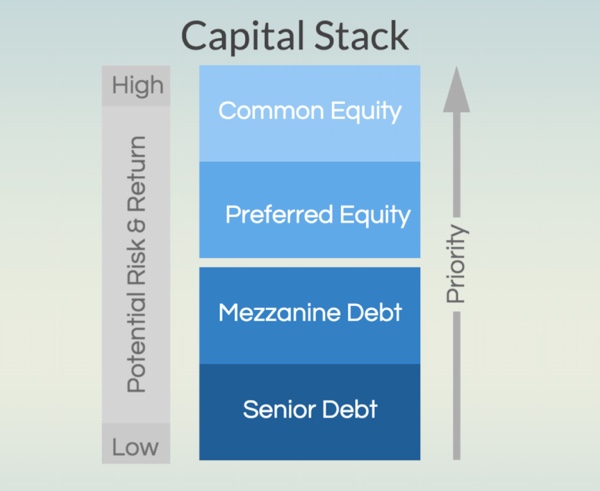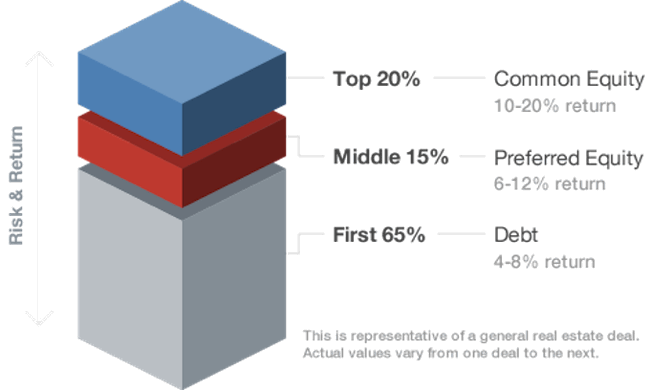Before I share more about my real-estate crowdfunding experiments, I wanted to take a quick step back in order to provide better context. Just as ETFs and mutual funds are separated into stocks and bonds, real estate can be separated into two general types of investments:
- Equity = an ownership interest in the asset.
- Debt = a loan, typically collateralized by the asset itself or other assets of the equity owner.
In the business world, I could buy a piece of Amazon or Apple and participate in the ups and down of the business value, or I could invest in bonds issued by Amazon or Apple and get a fixed return as long as Amazon and Google keep making their interest payments within the stated period of time.
This is called the “capital stack”. In residential real estate, the stack can be quite simple. There is one homeowner and one mortgage-holder (debt). If they ever sell the house, any proceeds must first go towards the mortgage-holder. Anything left over goes to the homeowners. If the house gets sold for $400,000 and had a $300,000 mortgage, the homeowner would get $100,000. When you see the image below (source), imagine water filling up a container. The bottom layer gets paid first. If there isn’t enough “water”, the next layer doesn’t get paid. If there is excess “water”, that goes to the equity owner. (image source)

In commercial real estate, here are the four most common layers of the capital stack: common equity, preferred equity, mezzanine debt, and senior debt. Preferred equity, as its location suggests, is in between common equity and debt in terms of cashflow priority and return upside potential. It has a more senior position to cashflow than common equity, but it still junior to mezzanine and senior debt. Mezzanine debt can be explained as similar to when a homeowner might also take out a “home equity loan” that junior to the first mortgage (and thus usually at a higher interest rate). Both of these intermediate stacks are more complex in terms of how much extra return are you getting for how much extra risk, and thus I tend to avoid them. (image source)

The expected return of each layer is then adjusted based on its position in the stack. Keep in mind that as your expected return increases, so does the possibility that your actual return is zero or negative. (image source)

My equity investments. My initial feeling was that publicly-traded REITs do a pretty good job on the equity side. The big REITs hold big apartment complexes, hundreds of public storage facilities, etc. Is there an opportunity for higher returns from smaller properties? Perhaps, but the problem is that it takes years for equity investments to pan out. My plan is to invest another $1,000 into Fundrise eREITs and hold on to them for 5 years as a long-term experiment. As the dividends are paid and the net asset value is updated, I can compare side-by-side with the dividends and net asset value of the low-cost Vanguard REIT ETF (VNQ).
My debt investments. I prefer the idea of providing short-term, 7%-9% loans backed by a hard asset like real estate. This is an area traditional referred to as “hard money loans”. I can’t replicate this type of deal with an ETF or mutual fund. I plan to increase my investment in PeerStreet to roughly $25,000 total as they focus 100% on the debt side and I like their platform so far. I invest only in notes with a term under 12 months, and in the first position (most senior). This remains under my “5% Speculative Portfolio” and will track my returns regularly.
 The Best Credit Card Bonus Offers – 2025
The Best Credit Card Bonus Offers – 2025 Big List of Free Stocks from Brokerage Apps
Big List of Free Stocks from Brokerage Apps Best Interest Rates on Cash - 2025
Best Interest Rates on Cash - 2025 Free Credit Scores x 3 + Free Credit Monitoring
Free Credit Scores x 3 + Free Credit Monitoring Best No Fee 0% APR Balance Transfer Offers
Best No Fee 0% APR Balance Transfer Offers Little-Known Cellular Data Plans That Can Save Big Money
Little-Known Cellular Data Plans That Can Save Big Money How To Haggle Your Cable or Direct TV Bill
How To Haggle Your Cable or Direct TV Bill Big List of Free Consumer Data Reports (Credit, Rent, Work)
Big List of Free Consumer Data Reports (Credit, Rent, Work)
After doing research and debating putting money into fundrise, I decided against it. I didn’t like the fact that your position only lasts 5, 7 , or 10 years. The allure of common stock is unlimited upside. If the plan from the get-go is for the initial builder to buy your position after 5, 7 ,or 10 years that significantly takes away from the upside. You take much of the risk that the project will fail, and don’t get to enjoy the returns after you know the project is successful. I’d be interested on your take.
PS After deciding not to put money in, the amount of SPAM texts/emails and cold calls I received also confirmed this. What kind of a “brokerage” needs to call/pressure people into investing
I think the ability to hold for a long time is a good consideration. I suppose the other side is that ideally the money is made in deciding where/when/how to start the project. Then when everything is stabilized and fully developed, you take your money and go into another development/investment. I’m just going to sit back and see how this one works out.
I haven’t had much problem with Fundrise. They all e-mail you unless you tell them to stop but I don’t think they’ve ever called, although I think another RE site has called me (just once). Honestly, my biggest problem right now is charities. There needs to be an indication for “if you don’t stop bugging me I’m going to give to another charity next year”.
I’m new to REITs, but I’ve heard a lot about issues with taxation of these assets. Does the REIT composition make a big difference or are all REITs similar from a taxation perspective?
For me, taxation with these real estate marketplace sites has been quite simple. Either a 1099-DIV or 1099-INT. Much easier than LendingClub or Prosper with all those little tax lots.